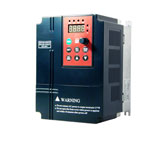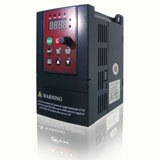VFD reactor
Quality VFD's incorporate either an AC Reactor or DC Reactor (choke). Their inclusion in the basic design of the VFD allows the design engineer to maximize the advantages of the choke. Their function is to reduce the current distortion caused by the input stage rectifiers by slowing the rate of change of current, and thus charging the internal capacitor at a slower rate over a longer time.
Some VFD's allow aftermarket fitment of DC chokes but access to the DC bus is required. While it is easy to add AC chokes to the input stage, there is a disadvantage of voltage drop to the VFD that may have to be considered.
The Harmonic Distortion caused by a VFD is related to its size & load, choke size, and the supply network parameters.
With no AC Reactor or DC Choke, the harmonic distortion will be greater.
Another consideration should be a properly sized source transformer that provides enough impedance. The sized source transformer used as an isolation transformer (although a bit more of an investment) should provide 3 to 5% impedance yet also provides Voltage Transient mitigation with ten to one reduction in impulse peaks, as well as noise reduction through the use of a Delta primary to Wye secondary with center tap ground. As Joe above states it provides additional protection for the VFD drives front (Converter) end while proper ground of the Source to Drive, Drive to Motor and Motor to Voltage Source assists in mitigating high frequency noise, especially when flat braid is used as the grounding straps. This protects your investment and assists in keeping the VFD's from generating noise into the supply that can compromise your nearby instrumentation, and PLC power supplies, etc. As well you can tap up the transformer giving you a higher input voltage mitigating the voltage drop issues resulting from the higher impedance.
The DC link assists in mitigating DC Bus Ripple and increasing the input impedance enabling a slower inrush for power on and sudden demand current requirements furthering the life of your capacitors, while a sized supply transformer protects the front end of the drive by providing voltage noise protection and adding input impedance for smoother current and adding a capability to change taps to prevent a voltage drop, while input reactors slow inrush current furthering the life of your input components and capacitors but add no protection from Voltage impulses or noise to the variable frequency drive converter components, and add voltage drop increasing stress on those components. The important thing to remember is that “Proper” systemic design protects your drive(s) and system components investment.
Some VFD's allow aftermarket fitment of DC chokes but access to the DC bus is required. While it is easy to add AC chokes to the input stage, there is a disadvantage of voltage drop to the VFD that may have to be considered.
The Harmonic Distortion caused by a VFD is related to its size & load, choke size, and the supply network parameters.
With no AC Reactor or DC Choke, the harmonic distortion will be greater.
Another consideration should be a properly sized source transformer that provides enough impedance. The sized source transformer used as an isolation transformer (although a bit more of an investment) should provide 3 to 5% impedance yet also provides Voltage Transient mitigation with ten to one reduction in impulse peaks, as well as noise reduction through the use of a Delta primary to Wye secondary with center tap ground. As Joe above states it provides additional protection for the VFD drives front (Converter) end while proper ground of the Source to Drive, Drive to Motor and Motor to Voltage Source assists in mitigating high frequency noise, especially when flat braid is used as the grounding straps. This protects your investment and assists in keeping the VFD's from generating noise into the supply that can compromise your nearby instrumentation, and PLC power supplies, etc. As well you can tap up the transformer giving you a higher input voltage mitigating the voltage drop issues resulting from the higher impedance.
The DC link assists in mitigating DC Bus Ripple and increasing the input impedance enabling a slower inrush for power on and sudden demand current requirements furthering the life of your capacitors, while a sized supply transformer protects the front end of the drive by providing voltage noise protection and adding input impedance for smoother current and adding a capability to change taps to prevent a voltage drop, while input reactors slow inrush current furthering the life of your input components and capacitors but add no protection from Voltage impulses or noise to the variable frequency drive converter components, and add voltage drop increasing stress on those components. The important thing to remember is that “Proper” systemic design protects your drive(s) and system components investment.



